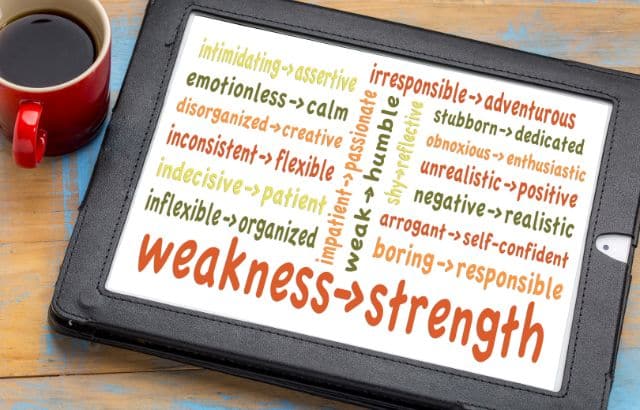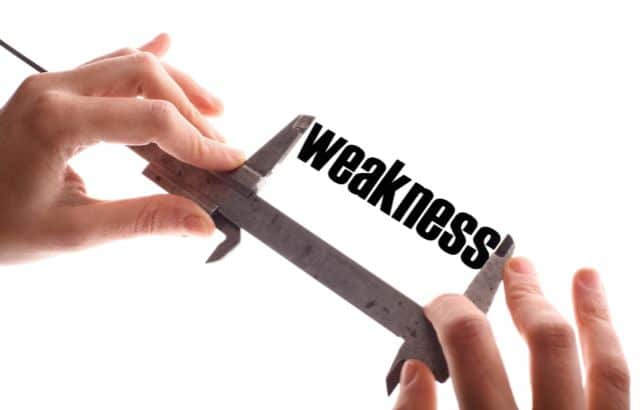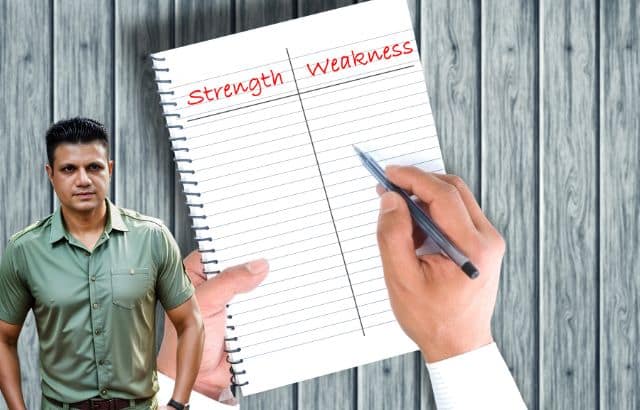In a world that often celebrates strength and resilience, acknowledging our weaknesses can feel uncomfortable and even daunting. Yet, understanding and accepting our vulnerabilities is an essential aspect of personal growth and self-awareness. In this blog post, we’ll delve into the concept of weakness, why everyone has their own, and how embracing these vulnerabilities can lead to greater strength and authenticity.
Table of Contents
Discovering Your Weakness
Here are some basic questions and answers on the terminology of weakness:
What is a weakness?
Answer: A weakness is a personal limitation or area of vulnerability that may hinder one’s performance, growth, or effectiveness in certain situations.
What are common types of weaknesses?
Answer: Common types of weaknesses include lack of skill or expertise, poor time management, difficulty with communication, tendency towards perfectionism, and challenges with organization or prioritization.
How can weaknesses be identified?
Answer: Weaknesses can be identified through self-assessment, feedback from others, performance evaluations, personality assessments, journaling, professional assessments, trial and error, asking tough questions, comparing oneself to others, and regular reflection.
Why is it important to identify weaknesses?
Answer: Identifying weaknesses is important because it allows individuals to understand areas where they may need to improve or develop, which can lead to personal and professional growth. It also enables individuals to leverage their strengths and seek support or resources to address areas of weakness.
How should weaknesses be addressed?
Answer: Weaknesses can be addressed through self-awareness, skill development, seeking feedback and guidance, setting goals for improvement, practicing self-compassion, and leveraging strengths to compensate for weaknesses. It’s also important to recognize that everyone has weaknesses and to approach them with curiosity and a growth mindset.
What is the difference between a weakness and a strength?
Answer: While weaknesses represent areas of limitation or vulnerability, strengths are qualities or attributes that individuals excel in or demonstrate proficiency. While weaknesses may require development or improvement, strengths can be leveraged to achieve success and overcome challenges.
How can weaknesses impact personal and professional life?
Answer: Weaknesses can impact personal and professional life by hindering performance, limiting opportunities for advancement, causing stress or frustration, and affecting relationships with others. However, addressing weaknesses can lead to increased confidence, competence, and overall well-being.
Can weaknesses change over time?
Answer: Yes, weaknesses can change over time as individuals learn and grow, acquire new skills, and adapt to different circumstances. It’s important to regularly reassess and address weaknesses to ensure ongoing personal and professional development.
How can weaknesses be viewed as opportunities for growth?
Answer: Weaknesses can be viewed as opportunities for growth by providing valuable insights into areas where individuals can focus their efforts and resources to improve. Embracing weaknesses with a growth mindset allows individuals to learn from challenges, develop resilience, and ultimately achieve greater success and fulfillment.
What role does self-awareness play in addressing weaknesses?
Answer: Self-awareness is essential in addressing weaknesses as it allows individuals to recognize and acknowledge areas where they may need to improve. By cultivating self-awareness, individuals can take proactive steps to address weaknesses, seek support or resources as needed, and ultimately achieve personal and professional growth.
Why Everyone Has Their Own Weakness:
Human Nature: From the most successful leaders to the most accomplished individuals, everyone has weaknesses. It’s a fundamental aspect of being human, and it’s what makes each of us unique.
Complexity of Individuals: Each person is a complex tapestry of experiences, beliefs, and emotions. Our weaknesses stem from this complexity, shaped by our upbringing, life experiences, and inherent traits.
Subjectivity of Weakness: What constitutes a weakness for one person may not be perceived as such by another. Our weaknesses are subjective and can vary greatly depending on individual perspectives and circumstances.
How to Find Out Your Weakness:
Self-Assessment:
Explanation: Self-assessment involves introspection and reflection on your own experiences, behaviors, and patterns.
Strategy: Set aside dedicated time for self-reflection, journaling, or meditation to explore your thoughts, feelings, and behaviors.
Execution: Keep a journal to record your reflections, insights, and observations. Create prompts or questions to guide your self-assessment process, such as “What challenges did I face this week, and how did I respond to them?”
Feedback from Others:
Explanation: Seeking feedback from trusted individuals provides an external perspective on your strengths and weaknesses.
Strategy: Approach individuals who know you well and who you trust to provide honest and constructive feedback.
Execution: Schedule one-on-one conversations or feedback sessions with friends, family members, colleagues, or mentors. Ask specific questions, such as “What areas do you think I could improve upon?” or “In what situations do you see me struggling?”
Personality Assessments:
Explanation: Personality assessments can offer insights into your natural tendencies, preferences, and potential areas of weakness.
Strategy: Take reputable personality assessments, such as the Myers-Briggs Type Indicator (MBTI), to gain a deeper understanding of your personality traits.
Execution: Review the results of the assessment and consider how your personality traits may impact your behavior, decision-making, and interactions with others. Look for patterns or tendencies that may indicate areas for development.
Performance Reviews:
Explanation: Performance reviews provide feedback on your performance and areas for improvement in professional or academic settings.
Strategy: Review past performance evaluations, assessments, or feedback from supervisors, peers, or teachers.
Execution: Identify recurring themes or areas for development mentioned in performance reviews. Look for specific examples or instances where you received feedback on areas of weakness.
Journaling:
Explanation: Journaling allows you to track your thoughts, feelings, and experiences over time, providing insights into your internal world.
Strategy: Commit to regular journaling sessions to capture your daily experiences, emotions, and reflections.
Execution: Set aside time each day or week to write in your journal. Use prompts or questions to guide your writing, such as “What challenges did I encounter today, and how did I handle them?” Review your journal entries regularly to identify recurring patterns or themes.
Professional Assessments:
Explanation: Seeking professional guidance from a career coach, therapist, or counselor can provide objective insights into your strengths and weaknesses.
Strategy: Research and select a qualified professional who specializes in personal development or career counseling.
Execution: Schedule an appointment with the professional to discuss your goals, challenges, and areas for growth. Be open and honest during the assessment process, and actively participate in any exercises or activities recommended by the professional.
Trial and Error:
Explanation: Experimenting with new experiences or challenges outside of your comfort zone can highlight areas where you feel uncertain or struggle.
Strategy: Identify opportunities to step outside of your comfort zone and try new activities, hobbies, or projects.
Execution: Take calculated risks and actively seek out opportunities for growth and learning. Reflect on your experiences and lessons learned from each new challenge or experience.
Ask Yourself Tough Questions:
Explanation: Asking probing questions about your values, beliefs, and behaviors can reveal underlying weaknesses or areas for improvement.
Strategy: Challenge yourself to ask tough questions and explore uncomfortable truths about yourself.
Execution: Set aside dedicated time for self-inquiry and introspection. Use open-ended questions to prompt deep reflection, such as “What aspects of myself do I find most challenging to accept?” or “What recurring patterns or behaviors hold me back from reaching my full potential?”
Comparison to Others:
Explanation: While comparing yourself to others should be done cautiously, observing how others excel in areas where you struggle can provide valuable insights.
Strategy: Identify individuals whom you admire or consider successful in areas where you feel you may have weaknesses.
Execution: Study the behaviors, habits, and strategies of these individuals. Look for lessons or techniques that you can apply to your own life to address areas of weakness or improve your performance.
Regular Reflection:
Explanation: Regular reflection involves setting aside dedicated time to assess your strengths, weaknesses, and areas for improvement.
Strategy: Establish a routine or schedule for regular self-assessment and reflection.
Execution: Set aside time each week or month to review your progress, set new goals, and identify areas for development. Use journaling, meditation, or other reflective practices to deepen your self-awareness and understanding of your weaknesses.
By utilizing these strategies and approaches, you can gain valuable insights into your weaknesses and areas for growth. Remember that self-awareness is an ongoing process, and embracing your weaknesses with curiosity and openness is a powerful step towards personal and professional development.
Exercise:
Taking Action: From Weakness to Powerhouse
Once you’ve identified your weaknesses, it’s time to create a plan of attack. Here are some tips:
Start Small: Don’t try to tackle everything at once. Choose one weakness to focus on and set manageable goals to address it.
Seek Guidance: Consider seeking help from a coach, therapist, or taking relevant courses/workshops to address specific skill gaps.
Celebrate Milestones: Acknowledge and celebrate your progress, no matter how small. This keeps motivation high and reinforces positive change.
Weakness Quotes:
Here are 10 weakness quotes along with explanations, strategies, and execution:
“Weakness is not a sign of failure, but an opportunity for growth.”
Explanation: This quote emphasizes that weaknesses should not be viewed as shortcomings or failures, but rather as opportunities for personal and professional development.
Strategy: Embrace a growth mindset that recognizes challenges and setbacks as opportunities for learning and improvement.
Execution: When faced with a weakness or setback, approach it with curiosity and openness. Reflect on what you can learn from the experience and how you can use it to become stronger and more resilient in the future.
“The greatest strength lies in acknowledging and addressing your weaknesses.”
Explanation: Acknowledging weaknesses requires courage and self-awareness, but doing so allows individuals to take proactive steps towards growth and improvement.
Strategy: Practice self-awareness by regularly assessing your strengths and weaknesses. Set aside time for introspection and reflection on areas where you may need to improve.
Execution: Take concrete steps to address your weaknesses, whether it’s seeking feedback, acquiring new skills, or seeking support from others. By acknowledging and addressing your weaknesses, you can unlock your full potential and achieve greater success.
“Weakness is the canvas upon which strength is painted.”
Explanation: This quote highlights the interconnectedness of weakness and strength, suggesting that weaknesses provide the foundation upon which strengths can be built.
Strategy: Embrace your weaknesses as opportunities for growth and development. Recognize that addressing weaknesses is an essential part of the journey towards building greater strength and resilience.
Execution: Identify areas where you feel challenged or struggle, and commit to addressing them through learning, practice, and perseverance. View each weakness as a blank canvas waiting to be transformed into a source of strength and empowerment.
“Strength grows in the moments when you think you can’t go on, but you keep going anyway.”
Explanation: Overcoming weaknesses requires resilience and determination. It’s in the moments of struggle and adversity that true strength is forged.
Strategy: Cultivate resilience by reframing setbacks as opportunities for growth and learning. Develop coping strategies to navigate challenges and setbacks effectively.
Execution: When faced with a weakness or obstacle, summon your inner strength and persevere. Break down larger goals into smaller, manageable tasks, and celebrate small victories along the way. By staying resilient and persistent, you can overcome any obstacle that stands in your way.
“Our weaknesses do not define us; it’s how we choose to address them that shapes our character.”
Explanation: This quote emphasizes the power of choice in how we respond to our weaknesses. While we may not always have control over our weaknesses, we do have control over how we choose to address and overcome them.
Strategy: Practice self-compassion and acceptance towards your weaknesses. Focus on what you can control and take proactive steps towards improvement.
Execution: Take ownership of your weaknesses and commit to addressing them with intention and determination. Seek support from others, set realistic goals for improvement, and celebrate your progress along the way. Remember that your character is defined not by your weaknesses, but by the actions you take to overcome them.
“In vulnerability lies our greatest strength.”
Explanation: This quote suggests that embracing vulnerability and acknowledging our weaknesses can lead to greater strength and resilience.
Strategy: Practice vulnerability by opening up about your struggles and challenges to trusted friends, family members, or mentors. Recognize that vulnerability is not a sign of weakness, but rather a sign of courage and authenticity.
Execution: Share your vulnerabilities with others in a safe and supportive environment. Allow yourself to be seen and heard, knowing that vulnerability is the birthplace of connection and growth.
“The only real mistake is the one from which we learn nothing.” – Henry Ford
Explanation: Mistakes and failures are inevitable, but they provide valuable opportunities for learning and growth.
Strategy: Embrace a growth mindset that views mistakes as learning opportunities. Reflect on your failures and setbacks to identify areas for improvement and growth.
Execution: When you encounter a setback or failure, take the time to reflect on what went wrong and what you can learn from the experience. Use this knowledge to adjust your approach and move forward with greater wisdom and resilience.
“Strength doesn’t come from what you can do; it comes from overcoming the things you once thought you couldn’t.” – Rikki Rogers
Explanation: True strength is not measured by what we can accomplish, but by our ability to overcome challenges and obstacles.
Strategy: Cultivate resilience by embracing challenges as opportunities for growth and learning. Develop coping strategies to navigate difficult situations with grace and determination.
Execution: When faced with a challenge or obstacle, approach it with courage and determination. Break the challenge down into smaller, manageable steps and focus on making progress one step at a time. Draw strength from past experiences where you have overcome adversity, knowing that you have the resilience to overcome any obstacle that comes your way.
“Our greatest glory is not in never falling, but in rising every time we fall.” – Confucius
Explanation: True strength is demonstrated not by avoiding failure, but by our ability to persevere and rise again after we fall.
Strategy: Develop resilience by reframing failures as opportunities for growth and learning. Practice self-compassion and kindness towards yourself during difficult times.
Execution: When you experience a setback or failure, remind yourself that it is not the end of the road but a detour on the journey towards success. Pick yourself up, dust yourself off, and keep moving forward with determination and resilience.
“The only way to grow is to embrace your weaknesses and turn them into strengths.”
Explanation: Embracing our weaknesses is the first step towards personal and professional growth. By acknowledging and addressing our weaknesses, we can unlock our full potential and become stronger, more resilient individuals.
Strategy: Take ownership of your weaknesses and commit to addressing them with intention and determination. Set realistic goals for improvement and seek support from others when needed.
Execution: Identify specific weaknesses that you want to address and develop a plan of action for improvement. Break down your goals into smaller, achievable steps and track your progress over time. Celebrate your successes and use them as motivation to continue growing and evolving as a person.
By embracing our weaknesses with courage and determination, we can unlock our full potential and become stronger, more resilient individuals. Remember that weakness is not a sign of failure, but an opportunity for growth and learning. With the right mindset and approach, we can turn our weaknesses into strengths and achieve greater success and fulfillment in life.


























